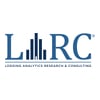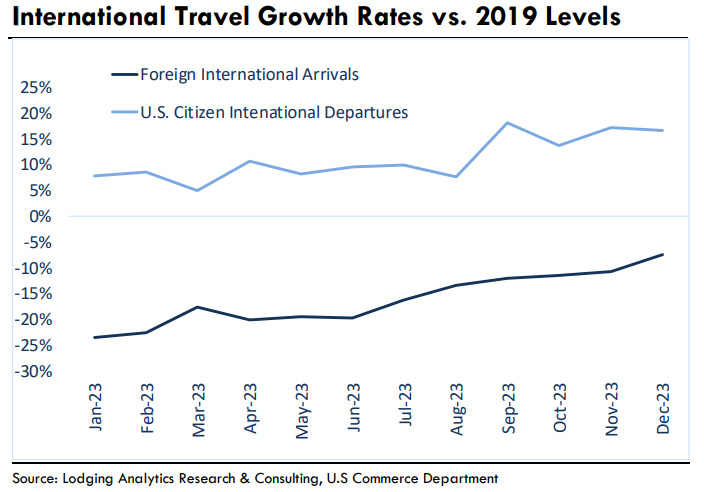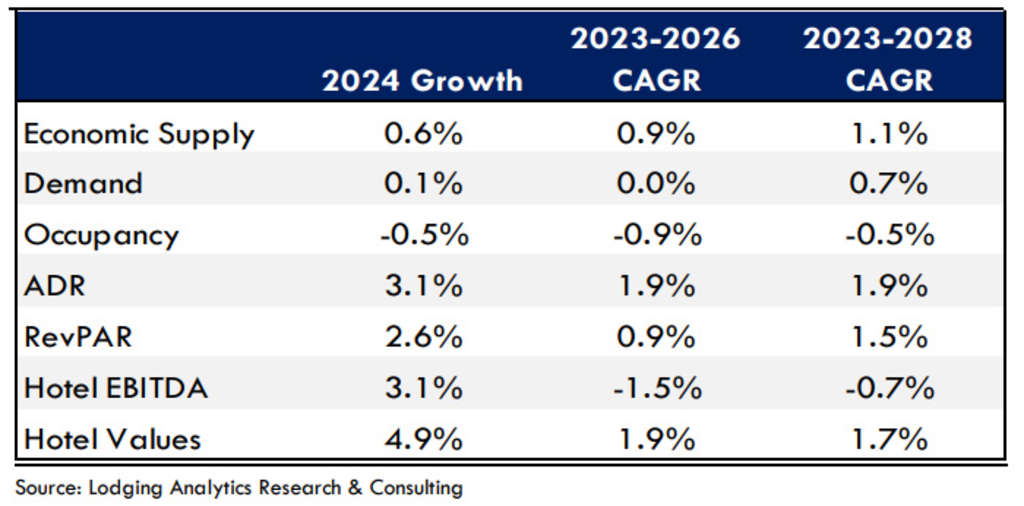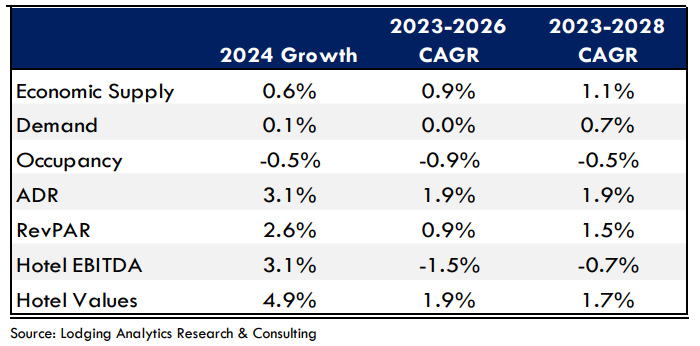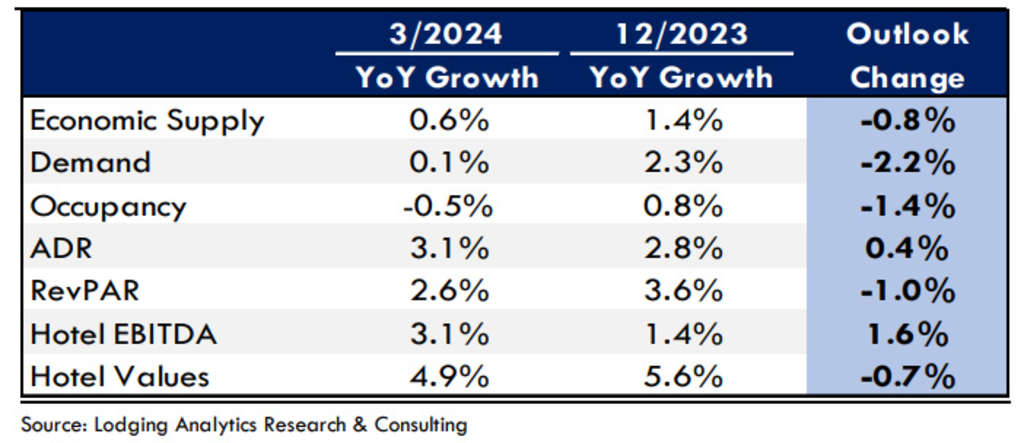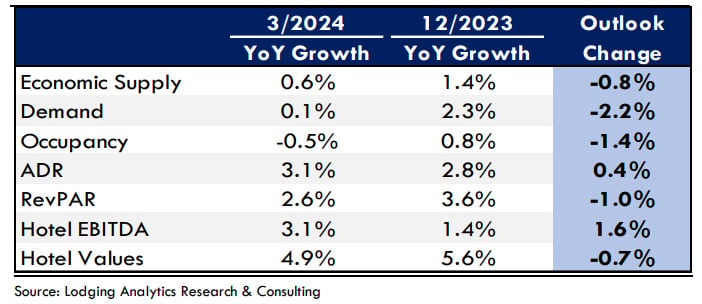Lodging Analytics Research & Consulting (LARC)’s 1Q-2024 Hotel Industry Outlook and Market Intelligence Reports
U.S. economic growth surprised to the upside in the fourth quarter with Real GDP increasing 3.3%, well above expectations, however below 3Q-2023’s 4.9% rise. Despite positive economic growth, U.S. RevPAR only increased 1.3%, as occupancy declined 1.6% during the quarter. While group demand continued to be strong, leisure demand continued to soften in 4Q-2023 and corporate transient demand did not accelerate as we had anticipated.
With positive fourth quarter macro-economic datapoints, the probability of a near-term recession has meaningfully moderated. As of January, only 39% of economists surveyed by the Wall Street Journal expect a recession within twelve months (the lowest level since April 2022). However, signs of a softening consumer are likely to continue to weigh on domestic leisure travel in 2024. The advance estimate for January retail sales points to a 0.8% contraction, following a 5.8% decline in Consumer Confidence in the fourth quarter. Additionally headline inflation rose 3.1% in January, proving to be increasingly stubborn and layering on risk to any near-term interest rate cuts that might stimulate economic growth.
In addition to these challenges, geopolitical risks related to the conflicts in the Middle East and Ukraine and an uncertain U.S. presidential election are likely to lead consumers and businesses alike to curtail spending in 2024. In fact, since 2000, presidential election years have seen Real GDP growth moderate by 110 bps on average vs. the prior year. In each of the past four presidential election years, both demand growth and RevPAR growth slowed from the prior year. Despite our baseline view of no near-term U.S. recession, Moody’s Analytics outlook for economic growth moving forward remains muted, with 2024 Real GDP increasing 2.3% and 2025 increasing just 1.6%. Moody’s Analytics expects business investment to increase just 3.0% in 2024, down from 4.3% in 2023.
In 2024, industry growth will be fueled by corporate transient, group, and inbound foreign travel while domestic leisure demand continues to wane. As economic growth remains positive, we expect continued gradual improvement in corporate transient demand, however, corporate transient demand growth will be limited by a sluggish return to the office. Group trends remain solid, helping generate a base level of demand that will further support pricing power. Nationally, we estimate that the convention center booking pace is up 3% on a year-overyear basis in 2024, following the 14% increase in 2023.
However, the booking pace is down 2% in 2025, so there is risk of group headwinds next year.
Additionally, foreign inbound travel to the U.S. was still 16% below 2019 levels in 2023, providing an opportunity for ample recovery in 2024. Momentum in foreign inbound travel remained strong through the end of 2023, with December levels just 8% below 2019 levels. Unfortunately, trends in U.S. outbound international travel also remain strong, which while comparisons will be much easier in 2024, trends are not encouraging.
It is important to note that not every market will benefit from foreign inbound travel recovery. Not even every gateway-oriented market will benefit. Every market has experienced a different level of recovery of foreign travel and understanding these nuanced details is critical to understanding which markets will have tailwinds from inbound foreign travel and which ones will not.
Moody’s Analytics economic forecast incorporates the following key national assumptions that drive our outlook:
- The Fed has paused rate increases until cuts begin in mid-2024 and dropping 25 bps per quarter through 2025.
- Inflation will continue to gradually moderate.
- U.S. GDP will increase 1.6% in 1Q-2024 and 2.3% in 2024.
As we discussed at the ALIS conference in January 2024, given the aforementioned points, we had expected our 2024 RevPAR outlook to moderate with this update, which is exactly what has transpired. Our current 2024 RevPAR outlook moderates to 2.6% year-over-year growth, fueled by a 3.1% increase in ADR and 0.5% decrease in occupancy. Should any of the above core macroeconomic assumptions meaningfully change, it could have a substantial impact on our U.S. lodging industry forecast.
We continue to expect there to be U.S. lodging markets that materially outperform as well as those that underperform national averages. Generally, we expect markets with outsized exposure to corporate transient, group and inbound foreign travel recovery will be the outperformers, while markets with the greatest exposure to domestic leisure demand and those underperforming from a group pace perspective will be the laggards.
Furthermore, we anticipate hotel capitalization rates to stabilize, financing costs to moderate and transaction volumes to rebound. Expense pressures will become a substantial factor in identifying markets that are winners and those that are losers, especially with several major cities embarking on new union negotiations in the coming years. Wage and expense growth and their strain on margin growth materially shapes our views on markets that are best and worst for investment today.
Transparency surrounding forecasting is critical to the lodging industry. We believe the best business decisions are based on the highest quality data and information available at the time of making such conclusion(s). We take that approach with our forecasts, using the best and most relevant available information to provide the most likely outcomes.
LARC’s industry-leading market intelligence is available to help all industry participants navigate the current environment and position themselves for success. Please contact us directly to learn more about our services and products or if there is any other way we may be able to better serve you.
LARC’s Industry Outlook
Currently, Lodging Analytics Research & Consulting (LARC) expects U.S. RevPAR to increase by 2.6% to $100.50 in 2024, driven by ADR growth of 3.1% to $160.50 while occupancy declines 0.5% to 62.6%.
LARC forecasts 2024 U.S. Hotel EBITDA to grow 3.1% and Hotel Values to increase 4.9%. Over the next five years, LARC expects Hotel Values to increase 9%, or at a 1.7% CAGR.
March 2024 U.S. Hotel Industry Forecast Summary
LARC’s U.S. RevPAR model has an R-squared of 98.7% with a standard error of 2.9%, back-tested to 2000. LARC’s U.S. Cap Rate model has an R-squared of 98.5% with a standard error of 25 bps, back-tested to 2005.
2024 U.S. Hotel Industry Forecast: March 2024 Edition vs. December 2023 Edition
The above table illustrates a summary of LARC’s current U.S. Hotel Industry Outlook in contrast to last quarter’s outlook. Ultimately, our 2024 view for supply and demand both moderated, driving our occupancy forecast lower. Our outlook for ADR slightly improved, which combined with our reduced occupancy growth outlook, drives a 1.0% decrease to our 2024 RevPAR outlook. However, as the reduction was entirely fueled by occupancy, our Hotel EBITDA levels increased slightly. Negative revisions to our Hotel EBITDA forecast beyond 2024, along with revisions to the outlook for base rates led our hotel value outlook slightly lower for 2024.
Market Outlooks
Listed below are the best and worst performing markets based on our forecasts. Similar to LARC’s U.S. forecast, our market level forecasts are structured on multi-variable regression models with a high level of historical accuracy.
Additional detail regarding our market outlooks can be found in LARC’s Market Intelligence Reports. Please contact us if you are interested in purchasing any of LARC’s offerings.
2024
Top Markets for RevPAR Growth:
San Jose, Seattle, San Francisco, Honolulu & New Orleans
Bottom Markets for RevPAR Growth:
Omaha, Kauai, St. Petersburg, Portland (ME) & Palm Springs
5-Year Outlook
Top Markets for RevPAR Growth:
Maui, Portland (OR), Raleigh, Las Vegas & Miami
Bottom Markets for RevPAR Growth:
Kansas City, Cincinnati, Omaha, Boston & Dayton
Top Markets for Value Change:
Las Vegas, Los Angeles, Seattle, Charlotte & Orlando
Bottom Markets for Value Change:
Boston, Chicago, Austin, San Diego & Philadelphia
Ryan Meliker
President
Lodging Analytics Research & Consulting, Inc
